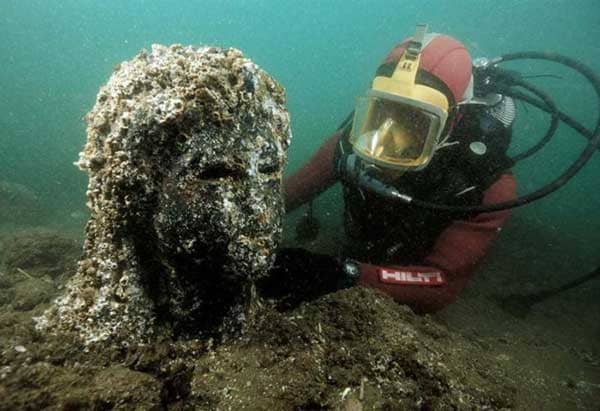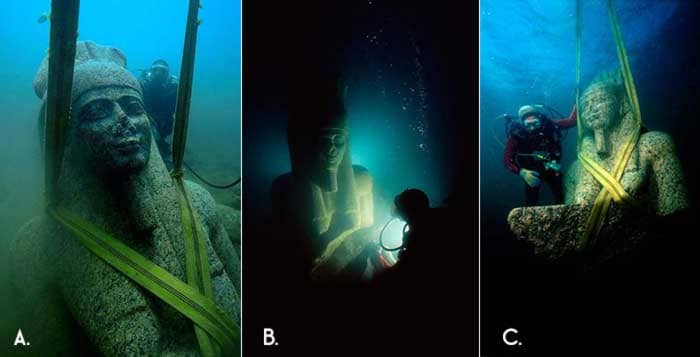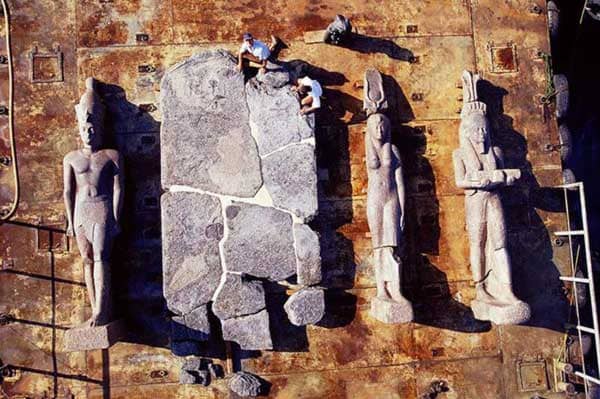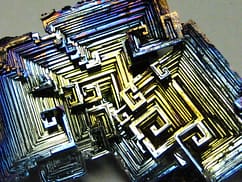Ancient City Discovered Underwater Solves Enigma That Puzzled Egyptologists For Years

LIKE ALTER MINDS ON FACEBOOK:
From Legend to Reality
Thonis-Heracleion (the Egyptian and Greek names of the city) is a city lost between legend and reality. Before the foundation of Alexandria in 331 BC, the city knew glorious times as the obligatory port of entry to Egypt for all ships coming from the Greek world. It had also a religious importance because of the temple of Amun, which played an important role in rites associated with dynasty continuity. The city was founded probably around the 8th century BC, underwent diverse natural catastrophes, and finally sunk entirely into the depths of the Mediterranean in the 8th century AD.
Prior to its discovery in 2000 by the IEASM, no trace of Thonis-Heracleion had been found. Its name was almost razed from the memory of mankind, only preserved in ancient classic texts and rare inscriptions found on land by archaeologists. The Greek historian Herodotus (5th century BC) tells us of a great temple that was built where the famous hero Herakles first set foot on to Egypt. He also reports of Helen’s visit to Heracleion with her lover Paris before the Trojan War. More than four centuries after Herodotus’ visit to Egypt, the geographer Strabo observed that the city of Heracleion, which possessed the temple of Herakles, is located straight to the east of Canopus at the mouth of the Canopic branch of the River Nile.
The Discovery
With his unique survey-based approach that utilises the most sophisticated technical equipment, Franck Goddio and his team from the IEASM, in cooperation with the Egyptian Supreme Council of Antiquities, were able to locate, map and excavate parts of the city of Thonis-Heracleion, which lies 6.5 kilometres off today’s coastline. The city is located within an overall research area of 11 by 15 kilometres in the western part of Aboukir Bay.
Scroll down for videos & pictures
Franck Goddio has found important information on the ancient landmarks of Thonis-Heracleion, such as the grand temple of Amun and his son Khonsou (Herakles for the Greeks), the harbours that once controlled all trade into Egypt, and the daily life of its inhabitants. He has also solved a historic enigma that has puzzled Egyptologists over the years: the archaeological material has revealed that Heracleion and Thonis were in fact one and the same city with two names; Heracleion being the name of the city for the Greeks and Thonis for the Egyptians.
The objects recovered from the excavations illustrate the cities’ beauty and glory, the magnificence of their grand temples and the abundance of historic evidence: colossal statues, inscriptions and architectural elements, jewellery and coins, ritual objects and ceramics – a civilization frozen in time.
The quantity and quality of the archaeological material excavated from the site of Thonis-Heracleion show that this city had known a time of opulence and a peak in its occupation from the 6th to the 4th century BC. This is readily seen in the large quantity of coins and ceramics dated to this period.
The port of Thonis-Heracleion had numerous large basins and functioned as a hub of international trade. The intense activity in the port fostered the city’s prosperity. More than seven hundred ancient anchors of various forms and over 60 wrecks dating from the 6th to the 2nd century BC are also an eloquent testimony to the intensity of maritime activity here.
The city extended all around the temple and a network of canals in and around the city must have given it a lake dwelling appearance. On the islands and islets dwellings and secondary sanctuaries were located. Excavations here have revealed beautiful archaeological material such as bronze statuettes. On the north side of the temple to Herakles, a grand canal flowed through the city from east to west and connected the port basins with a lake to the west.

Franck Goddio with the intact engraved Thonis-Heracleion stele of 1.90 m height, commissioned by Nectanebo I (378-362 BC) and almost identical to the Naukratis stele in the Egyptian Museum in Cairo. Its text names the site where it was erected: Thonis. ©Franck Goddio/Hilti Foundation, photo: Christoph Gerigk

An archaeologist measuring the feet and other fragments of a colossal statue after preliminary cleaning on site at Thonis-Heracleion in the Bay of Aboukir. ©Franck Goddio/Hilti Foundation, photo: Christoph Gerigk

Before bringing it to the surface, archaeologists Franck Goddio and his team inspect the colossal red granite statue of a pharaoh of over 5 metres height, weighing 5.5 tons, and shattered into 5 fragments. It was found close to the great temple of sunken Heracleion. ©Franck Goddio/Hilti Foundation, photo: Christoph Gerigk

Colossal red granite statue of a Ptolemaic queen, 4.9 m high and weighing 4 tons, found close to the great temple of sunken Heracleion. ©Franck Goddio/Hilti Foundation, photo: Christoph Gerigk

One of the finest finds in Abukir Bay is the remarkable dark stone statue of a 3rd century Ptolemaic queen, very probably Cleopatra II or Cleopatra III, wearing the tunic of the goddess Isis. ©Franck Goddio/Hilti Foundation, photo: Christoph Gerigk

A. B. C. – Colossal statue of red granite (5.4 m) representing Hapy, god of the Nile flood and symbol of abundance and fertility decorating the temple of Heracleion. Never before was such a huge statue of Hapy or any other god discovered in Egypt, which indicates Hapy’s importance for the Canopic branch, the largest and most important of the Nile branches at the time. ©Franck Goddio/Hilti Foundation, photo: Christoph Gerigk

A golden phial found in Thonis-Heracleion. Phials were shallow dishes used throughout the hellenistic world for drinking and pouring libations. ©Franck Goddio/Hilti Foundation, photo: Christoph Gerigk

A. One of the finest finds in Abukir Bay is the remarkable dark stone statue of a 3rd century Ptolemaic queen, very probably Cleopatra II or Cleopatra III, wearing the tunic of the goddess Isis. B. The stele of Thonis-Heracleion (1.90 m), ordered by Pharaoh Nectanebo I (378-362 BC), is almost identical to the stele of Naukratis in the Egyptian Museum of Cairo. The text of the stele mentions the site where it was erected: Thonis. ©Franck Goddio/Hilti Foundation, photo: Christoph Gerigk

The head of a colossal red granite statue of a pharaoh is raised to the surface. The entire statue measures over 5 metres and was found close to the great temple of sunken Heracleion. ©Franck Goddio/Hilti Foundation, photo: Christoph Gerigk

Franck Goddio and his team watch the rise to the surface of a colossal statue of red granite (5.4 m) representing the god Hapy, symbol of abundance and fertility and god of the Nile flood which stood in front of the temple of Heracleion. Never before has the statue of a god of this size been discovered in Egypt, which indicates Hapy’s importance for the Canopic branch, the largest and most important of the Nile branches at that time. ©Franck Goddio/Hilti Foundation, photo: Christoph Gerigk

Aerial view of the colossal triad of 5-metre high red granite statues of a pharaoh, his queen and the god Hapy, dating from the 4th century BC, which stood in front of the great temple of Heracleion. They are placed on a pontoon barge together with the 17 fragments of an over 5-metre high 2nd century BC red granite stele in reassembly; the workers on the pontoon provide a notion of the dimensions of these objects. ©Franck Goddio/Hilti Foundation, photo: Christoph Gerigk





